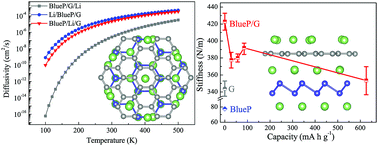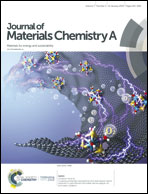Blue phosphorene/graphene heterostructure as a promising anode for lithium-ion batteries: a first-principles study with vibrational analysis techniques†
Abstract
van der Waals heterostructures can preserve the desired features of their individual components and induce new functions due to interlayer coupling. In this work, based on the dispersion-corrected density functional theory and vibrational analysis techniques, the blue phosphorene/graphene (BlueP/G) heterostructure was systematically studied as a potential anode for Li-ion batteries. It was found that the semi-metal characteristics of graphene are well preserved in the BlueP/G heterostructure, endowing it with excellent electrical conductance for fast electron transport. The binding energy of Li in the BlueP/G system is greatly increased due to the interfacial synergistic effect, as compared to pristine BlueP and graphene monolayers. Consequently, the theoretical specific capacity can be up to 626 mA h g−1, even exceeding that of the black phosphorene/G heterostructure (485 mA h g−1). The minimum diffusion barrier of Li on the BlueP/G system is only 0.13 eV, resulting in a room-temperature diffusivity of 2.61 × 10−5 cm2 s−1, which is two orders of magnitude faster than that on graphene. The impact of the vibrational contribution on the ionic diffusion is material-dependent and significant. More importantly, the BlueP/G heterostructure and its charge products display ultrahigh stiffness in the range of 353–422 N m−1 and an extremely small effective volume expansion of 10.89% for the fully charged product, which might alleviate the safety concerns commonly associated with huge volume expansion/contraction upon lithiation. These results demonstrate that the BlueP/G heterostructure could be a promising anode material for high-performance Li-ion batteries due to its excellent conductivity, strong adsorption and fast diffusion of Li, high energy capacity, and ultrahigh mechanical stability.

- This article is part of the themed collection: 2019 Journal of Materials Chemistry A HOT Papers


 Please wait while we load your content...
Please wait while we load your content...